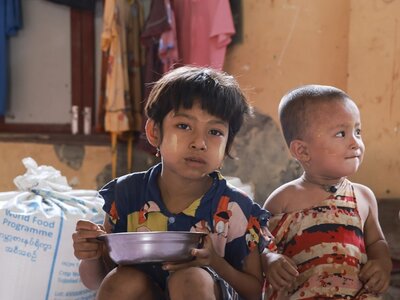Emergency
Myanmar
- 16.7 million
- people are food insecure
- 2.8 million-plus
- food-insecure people severely affected by 2025 earthquake
- US$60 million
- needed to reverse humanitarian assistance cuts
Myanmar is facing the worst humanitarian crisis in its recent history, affecting 20 million people.
A political crisis, conflict, economic downturn, pre-existing poverty, and climate-related shocks are all driving the hunger emergency, compounded by the recent powerful earthquake and significant cuts in humanitarian assistance.
The country has hit an all-time peak in hunger levels; a staggering 16.7 million people – almost one in three – are projected to be food insecure in 2025, up from 13.3 million last year. Myanmar now ranks fifth globally in the number of acutely food-insecure people, making it a hunger hotspot of very high concern.
A 7.7-magnitude earthquake struck central Myanmar on 28 March 2025, killing more than 3,700 people, destroying infrastructure and reverberating through neighbouring countries. Nearly 2.8 million food-insecure people were affected in the hardest-hit townships, including half a million who were already facing emergency levels of hunger.
The World Food Programme (WFP) has completed the first phase of its emergency response, reaching 400,000 people in Sagaing, Mandalay, southern Shan State and Nay Pyi Taw.
WFP provides life-saving food and cash assistance to internally displaced people and other vulnerable populations with little or no access to food and livelihoods. However this support is threatened by severe funding shortfalls.
WFP has been forced to cut life-saving humanitarian assistance for more than 1 million conflict-affected people across Myanmar since April 2025. WFP will only be able to provide support for 570,000 people in the lean season from July to September – covering only 20 percent of the population that is facing emergency levels of food insecurity.
WFP urgently needs US$60 million to reverse cuts to its humanitarian assistance for more than 1 million people in 2025.
What the World Food Programme is doing to respond to the Myanmar emergency
-
Emergency response
-
WFP has reached 400,000 earthquake-affected people in Sagaing, Mandalay, southern Shan State and Nay Pyi Taw with rapid food and cash for food. The WFP-led Logistics Cluster has established storage facilities for humanitarian assistance (including temperature-controlled storage) in Yangon and Mandalay that are available to all partners free-of-charge.
-
Nutrition
-
Resilience




